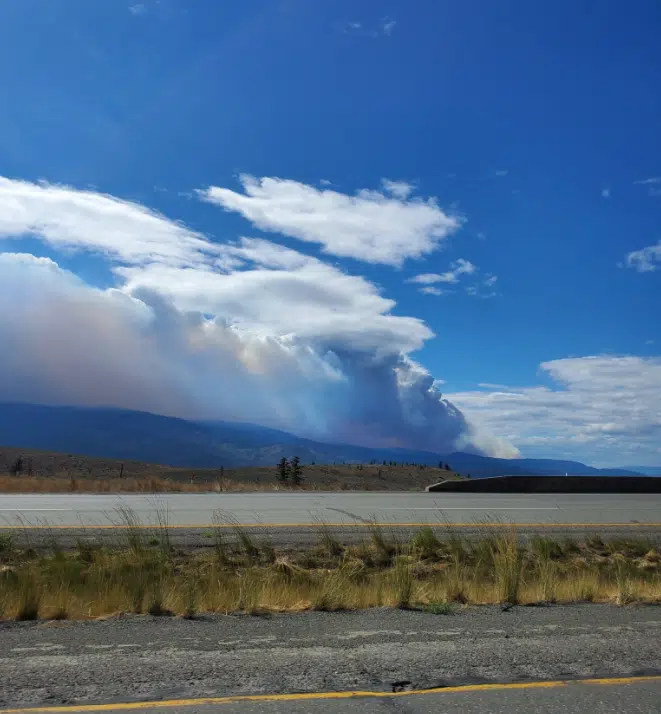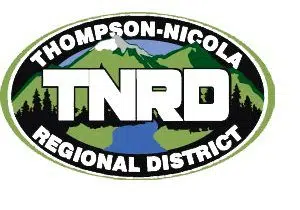
A controlled burn at the Tremont Creek wildfire on August 10, 2021, as seen from the Coquihalla Highway. (Photo via Jaclynn Bryan)
B.C.’s wildfire season is off to a slow start due to a wet spring and cool temperatures, but above-normal temperatures are forecast for July and August, increasing risks of wildfires.
However, lead forecaster, Matt MacDonald, says there are three parts of the province that have seen drier-than-normal conditions in May, including the Thompson-Okanagan, the South Cariboo, and the Rocky Mountain Trench.
“Stemming back to last fall, we had a really hot and dry summer. Heading into winter we had many pockets around the province that had elevated drought codes but fortunately with the La Nina winter that we saw, we saw ample amounts of precipitation and a lot of those drought codes have decreased,” he said.
“Drought codes aren’t so important early on in the season around June, but really it will come more into play as we get into July and August. They really represent the potential for these fires to get large.”
The Thompson-Okanagan was the focal point of last summer’s wildfire season – the third worst on record in B.C. history. There were 1,642 fires between April 1, 2021 and March 31, 2022, charring 869,279 hectares of land. A majority of that, 459 fires were sparked in the Kamloops Fire Centre, with 497,497 hectares charred.
“We’ve been lucky this season,” MacDonald added. “We’ve seen a total of 137 wildfires so far. If we compare to the five year average, that is approximately 60 per cent. If we compare it to the 25 year average, that is less than half the number of wildfires that we usually would have seen by this time of year.”
“If we look at the total number of hectares burned, we’re sitting at just over 600, and that is only five per cent of our 25 year average.”
MacDonald says there have been zero lightning caused fires this season, noting the vast majority have been confirmed to be human-caused. Normally, he says, more than half of fire starts come from lightning, adding a “big factor” moving forward will be if the lightning is accompanied by rain.
Further, he noted, the amount of rain we get in June typically determines the severity of the fire season in late July and August.
“Some of the patterns to watch out for are obviously these prolonged periods of dry spells which are typically followed by lightning outbreaks,” MacDonald said, when asked about preparations in the drier Thompson-Okanagan or South Cariboo, in the hopes of avoiding another smoky summer.
“Maintaining that awareness particularly in those areas of the province and just staying tuned to conditions as they change because it doesn’t take very long. It takes a matter of sometimes a week for conditions to change quite drastically.”
He was also asked about the likelihood of another ‘heat dome’ like we saw in June of last year, which saw temperatures well above 40 C.
“Some studies have shown that we could expect these heat dome like signatures to present themselves perhaps once in a decade. So while the likelihood of that occurring this summer is very low, it is not impossible,” MacDonald said.
“The forecastibility of these extreme events is only possible a week and a half to two weeks out, so right now, there is nothing like that on the horizon.”
Forests Minister, Katrine Conroy, said Friday that this year’s budget added $359 million in new funding to help the province fight wildfires. She says that included $145 million for the BC Wildfire Service and Emergency Management B.C., moving the wildfire service to a year-round operation.
“Last year’s devastating fire season highlighted the importance of wildfire prevention for B.C. communities and, as we saw first-hand in Logan Lake, how it can make a real difference for people’s lives,” Conroy said.
“That’s why our government is more than doubling the funding available for wildfire prevention activities like FireSmart and making historic investments to transform BC Wildfire Service into a year-round, more proactive service.”
For the latest on the wildfire season outlook in B.C., go here.\













